Hunting dogs do more than track down vermin. They’re also excellent at sniffing tracks, crossing expansive terrain, and pointing and retrieving. You’d love to adopt a hunting dog that’s ideally low-shedding as well.
Which hunting dogs shed little? Here’s the list:
- Pointer
- Glen of Imaal Terrier
- Pudelpointer
- German Shorthaired Pointer
- Wirehaired Pointing Griffon
- Airedale Terrier
- Irish Water Spaniel
- American Water Spaniel
- Vizsla
- Bedlington Terrier
In this guide, I’ll talk further about these dog’s hunting instincts as well as why they shed so little. By the time you’re done reading, you might just find the perfect dog for you!
Recommended: Go here to see our top-rated dog hair blow dryers
10 Hunting Dog Breeds That Don't Shed Much
1. Pointer
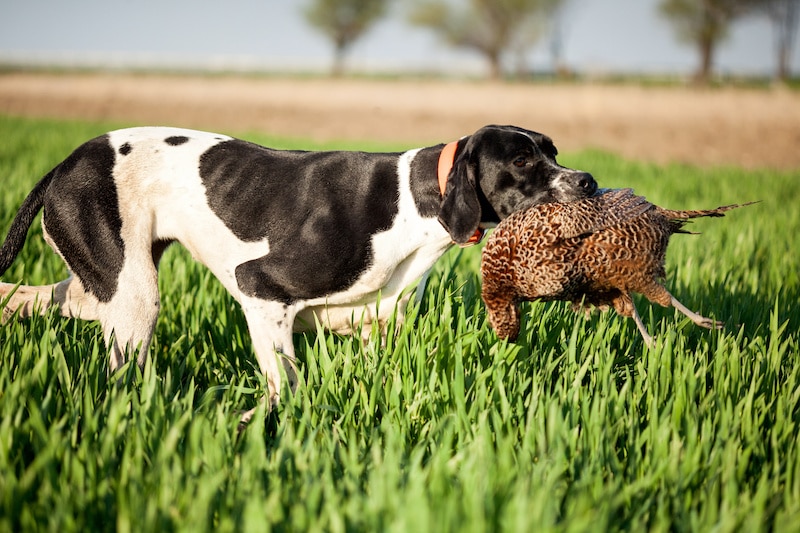
Pointers refer to lots of breeds, but the English Pointer is likeliest to be classified as the general Pointer dog.
The English Pointer is a hard-working dog that maintains its temper even in tough situations. Living for upwards of 17 years, English Pointers are surprisingly very affectionate with those they love.
They also get along well with children and other dogs and pets such as cats.
The glossy coat of the English Pointer sheds little. You’ll notice some hair loss as this breed’s hair cycle resets, but that’s nothing a quick cleaning of the house can’t fix.
Grooming isn’t difficult either, as the English Pointer needs brushing once a week with a bristle brush.
2. Glen of Imaal Terrier
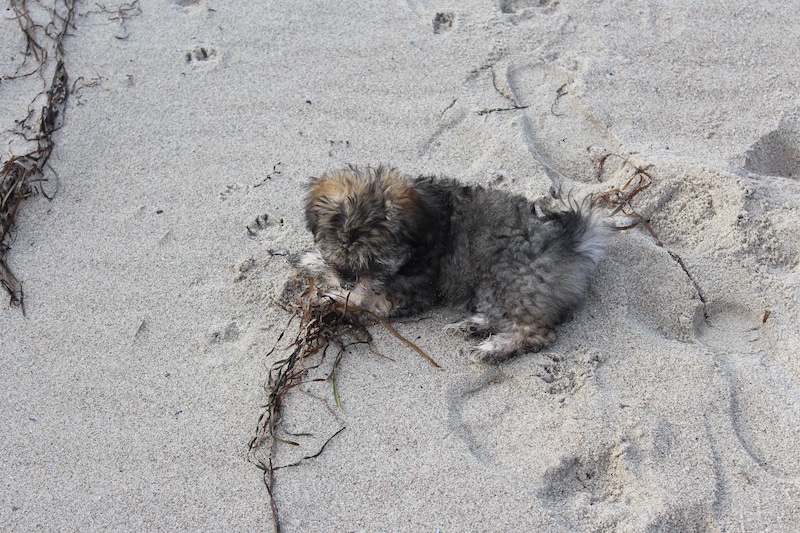
Although he doesn’t look particularly ferocious, the short-legged Glen of Imaal Terrier was especially adept at hunting badgers and otters. It wasn’t long after the 1590s–when the Glen was first bred–for people to realize he’s a great companion dog too.
Glens are smart, brave dogs that have a loving streak a mile wide. They might even follow you around the house all day since they love their people that much.
Yet Glens don’t do well with other dogs, and they especially don’t like small animals such as cats or rabbits. They still have their hunting instincts after all this time!
With a double coat, Glen of Imaal Terriers are seasonal shedders that will also lose fur occasionally during the rest of the year. Since he’s a Terrier though, the amount of shedding is little. Weekly brushing can reduce shedding further.
3. Pudelpointer
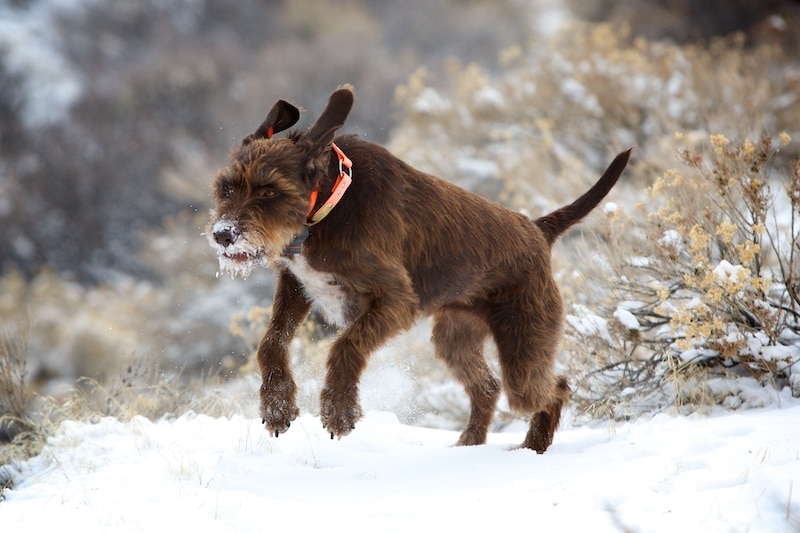
Here’s another low-shedding hunting dog: the Pudelpointer. As that name might allude to, this dog hails from Germany.
Not afraid of guns or game, the brave Pudelpointer is a mid-sized dog that is part Pointer and part Poodle. Its ancestors are both very low-shedding dogs, so it only makes sense that the Pudelpointer inherited that trait as well.
A heavier dog weighing up to 70 pounds, the Pudelpointer lives to please. This breed is also smart and very friendly despite its strong hunting instincts. Make sure you socialize your Pudelpointer around cats and small animals though.
Dogs are a natural companion of the Pudelpointer, as are children.
4. German Shorthaired Pointer
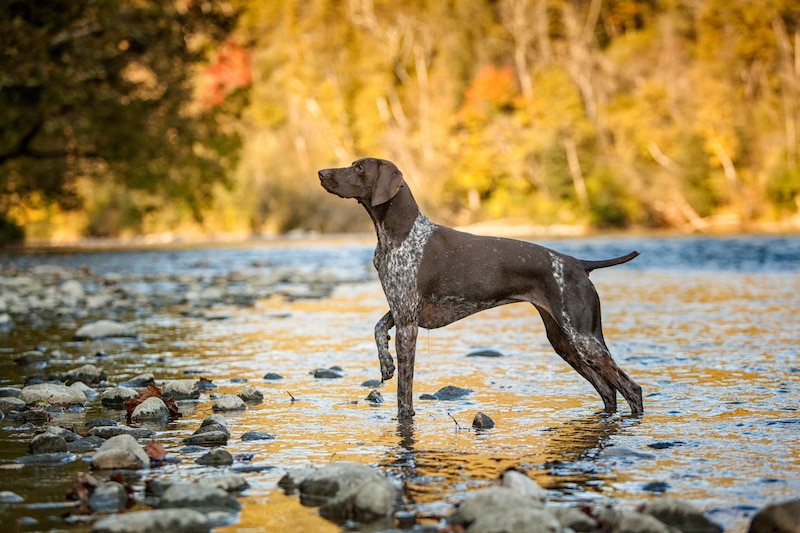
A sporting dog, the German Shorthaired Pointer or GSP also originates from Germany. It’s a slightly smaller dog than the Pudelpointer and one that too sheds very little. The reason for this is that the dog is rather short-haired.
Brushing and grooming your German Shorthaired Pointer can control the already moderate amount of hair this dog releases. I recommend brushing him at least once a week.
The GSP loves to make its favorite people happy. A very active pup that will gladly chase the children, the affection you get from a German Shorthaired Pointer will make you feel very special.
Just keep your GSP away from the small critters and pets such as cats or ferrets. This dog will give chase!
5. Wirehaired Pointing Griffon
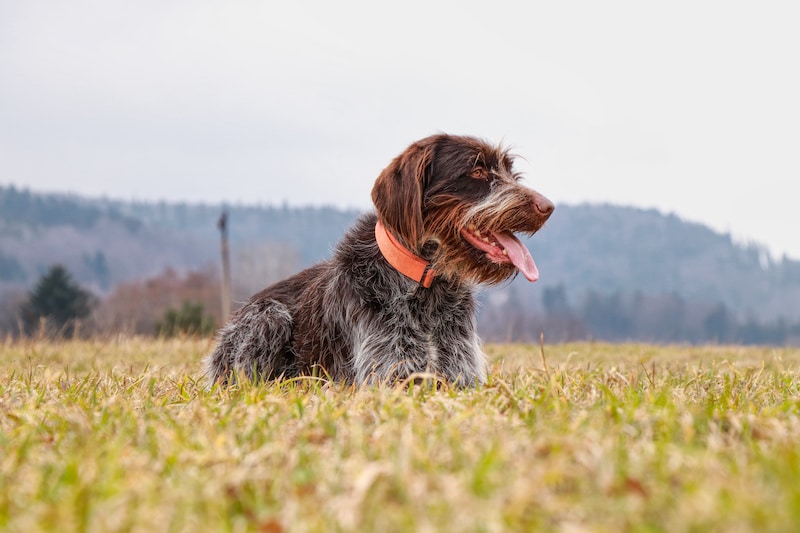
Bred to be a bird hunter, the Wirehaired Pointing Griffon is a large, shaggy dog that doesn’t shed nearly as much as you would think. It’s all due to its wiry coat.
Griffs might shed a little bit more during seasonal changes, and then throughout the year, some hair drop occurs as well. This is all very normal hair turnover for dogs though.
Brushing your dog about weekly using a comb will keep its shaggy fur a little more well-kept, and hand stripping from time to time is recommended as well.
Living with a Griff is great, as this breed is affectionate, very trainable, devoted, and good with children. With an average life expectancy of 15 years, it’s worth socializing your Wirehaired Pointing Griffon with your other dogs and even cats.
6. Airedale Terrier

A fantastic hunter and retriever, the Airedale Terrier is just the dog you’re looking for. This breed will retrieve feathered creatures like ducks as well as furry animals. They’re also highly athletic.
Despite that the Airedale is a large dog (that can weigh up to 70 pounds), it sheds little. You will see a bit of seasonal shedding since the Airedale Terrier is double-coated. Its outer layer of fur is short-cropped and wiry though, which means most of its coat stays on its body.
Although not exactly lovey-dovey, Airedales are sweet dogs. They’re also courageous and clever so you can feel safe with one in the house. Oh, and did I mention they’re kid-friendly as well?
Airedales can coexist with other dogs, but it’s sometimes begrudgingly. Smaller pets such as cats should not be in the same household as an Airedale Terrier.
7. Irish Water Spaniel

Fluffy, shaggy, and adorable, the Irish Water Spaniel or IWS is a working dog from Ireland that’s known for its surprisingly naked rat tail.
This is another one of those breeds that looks like it sheds tons but doesn’t. You will have to spend considerable time grooming the IWS, as he’s double-coated and curly. I’d suggest a pin brush or a slicker brush for combing, which you should do weekly or slightly more often.
A good companion of children, the IWS is sweet and playful yet keeps a close eye on what’s going on around the house. The dog is also quite adaptable, so go ahead, teach yours a few new tricks.
One area in which the Irish Water Spaniel is less adaptable is its preference for other pets. Some IWS dogs don’t like canines of their gender; others don’t mind. Most won’t like cats and small pets, but again, it depends on the dog.
8. American Water Spaniel
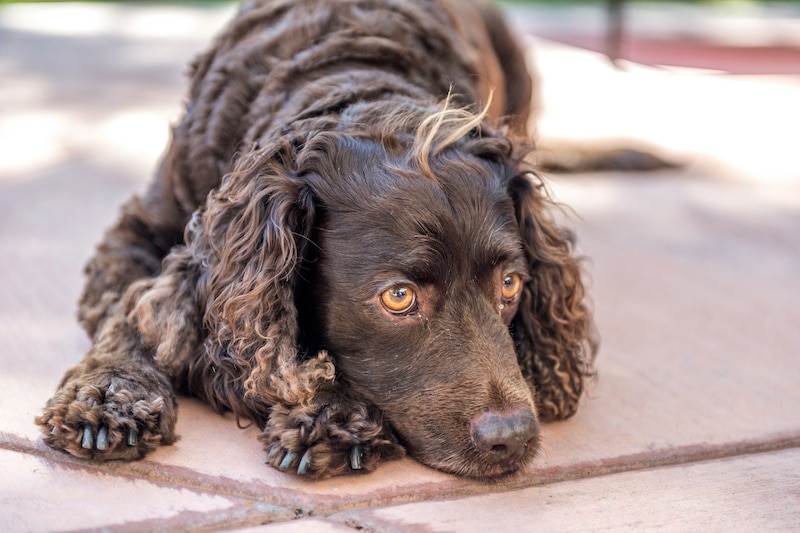
Yes, I’m going from the Irish Water Spaniel to the American Water Spaniel or AWS for short. This mid-sized dog (which tops out at around 45 pounds) originated in Wisconsin, where the AWS was bred to hunt during the 19th century.
Like IWS dogs, the AWS is also great at retrieving, be that a toy, a stick, or even a creature they hunted (or that you two hunted together).
Another trait that Irish and American Water Spaniels have in common is their low shedding propensity. Again, you’ll notice a bit of seasonal shedding and hair cell turnover during the rest of the year, but it’s all very mild.
Prepare to groom your AWS more, brushing the dog up to three times per week using a pin brush or a slicker brush. This can reduce the American Water Spaniel’s rate of shedding even further.
Here’s an important area where the IWS and AWS diverge: the American Water Spaniel is generally more amiable around other dogs and small pets like cats. That’s a testament to its happy, friendly, eager nature!
9. Vizsla

The Hungarian hunting dog the Vizsla would work long hours toiling in the fields back in the 1300s and later. The dog carries on its love of athletics and physical activity to this day.
The mid-sized Vizsla, which lives for upwards of 14 years, features a very neat, close-cropped coat. Although short-haired dogs can shed, you don’t see it as often, and the Vizsla is proof. The length of its coat also makes grooming easy-peasy.
Considered a loving and gentle dog, the Vizsla adores humans of all ages. By socializing your pup with cats and other dogs early on, the Vizsla will learn to get along with all.
10. Bedlington Terrier
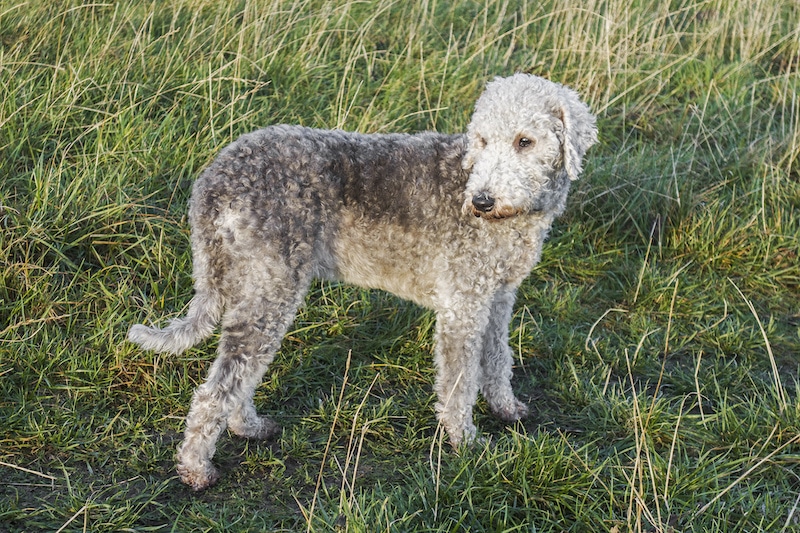
The last low-shedding hunting dog I want to talk about is the Bedlington Terrier. A mid-sized dog weighing about 23 pounds at most, this English Terrier would hunt vermin before people of the 1780s realized the Bedlington Terrier excelled at racing and dog sports too.
Oh, and he’s a great companion as well. Bedlington Terriers are very loyal and quite vigilant. They’re not super close with strangers, and they can get along with kids well enough.
As for other pets, socializing the Bedlington Terrier from an early age can ensure a more harmonious relationship. Even still, some Bedlington Terriers aren’t fond of other dogs that share their gender.
What about its rate of shedding? The Bedlington Terrier hardly sheds and is described by some as shed-proof (which isn’t true but shows how little this Terrier sheds).
Grooming is where the real bulk of your time will go towards. You have to brush this dog weekly with a slicker brush, then trim or shear the Bedlington Terrier to control its quick-growing fur!
Recommended: Go here to see our top-rated dog hair blow dryers
Bottom Line
The above 10 dog breeds are all renowned for their hunting, pointing, and/or retrieval instincts even though they’re domesticated pets today. Even better is that these dogs, despite that many of them are larger, don’t shed much at all.
I do want to reiterate one point. For the breeds that don’t coexist well with smaller animals, please don’t keep pets like a ferret, rabbit, or cat in the house with those dogs. If your small pet ends up getting hurt, it’s not your dog’s fault. He’s just acting on his instincts.
Early socialization can work, but you’re better off just having the dog alone or with other canines (if they get along!).
Also worth mentioning is that if your primary concern is pet allergies, it may be best to consider a hypoallergenic dog breed. The reason being, even though all dogs can trigger allergies, these breeds are generally considered more suitable for allergy sufferers.
If you want to learn more about hypoallergenic dogs, why dogs shed hair, and some of the ways you can reduce shedding, check out this helpful FAQ.
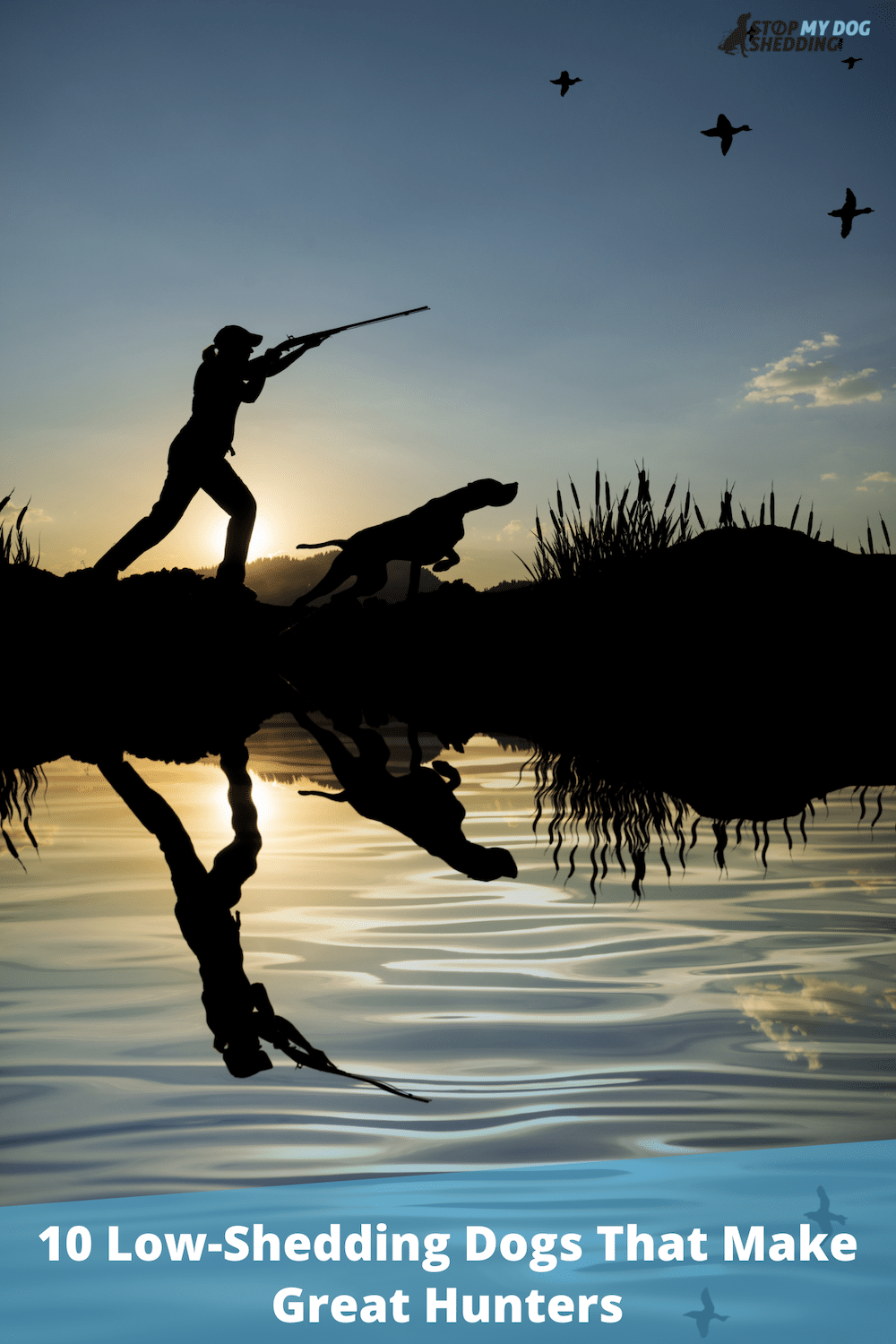

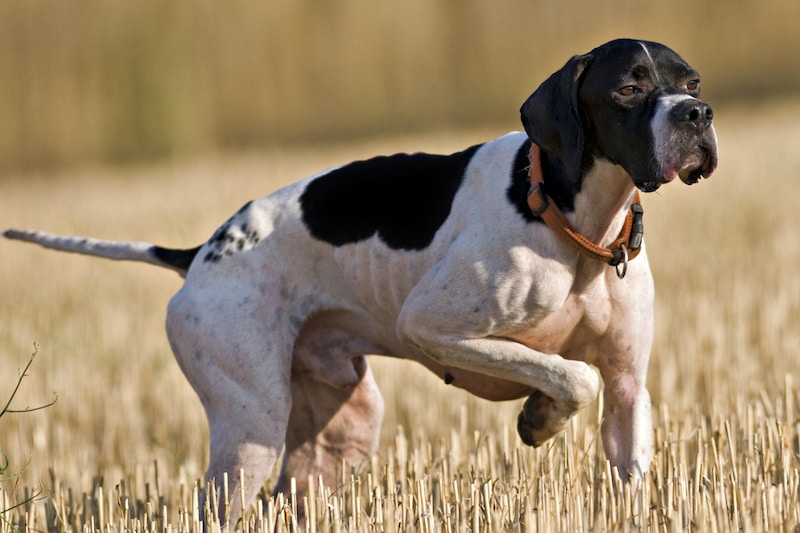










Please note: By submitting a comment using the above comment form, you confirm that you agree with the storage and handling of your data by this site as detailed in our Privacy Policy.